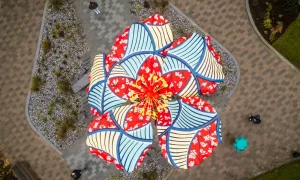
Few countries in Africa have been leading the charge in the contemporary art scene like Nigeria. In 2024, as Africa aims to buck the decades-long trend of under-representation at the Venice Biennale, all eyes will be on the west African country for its ambitious second-ever national pavilion, along with first-time participants Benin and Morocco, whose presence has been hailed as “a milestone for the continent”.
Aindrea Emelife, the 29-year-old curator of the Nigerian pavilion, doesn’t take the responsibility lightly. “It is extremely important – for Nigeria, for Africa. I feel like we are at the cusp of something – politically and culturally,” Emelife says, promising that the pavilion will “embrace the unexpected”, “show who we are”, and “shake off narrow stereotypes”.
Sunshine Alaibe, creative director of Art Report Africa, a hub for visual arts and culture in Nigeria, says artists, designers and film-makers from the continent are “bulldozing” their way on to the global stage. Events such as Art X Lagos (Nigeria), Dak’art (Senegal), 1-54 Marrakesh (Morocco), and Investec Cape Town Art Fair (South Africa), she says, “are broadening the minds of those that participate in the art market”.
Azu Nwagbogu, the Nigerian curator of the Benin pavilion, says: “The simultaneous participation of Benin and Morocco, two nations with rich artistic histories, marks a milestone for the continent.
“Benin’s distinctive visa-free, open-border policy, a rarity on the continent, has birthed a cultural renaissance for Africa,” he adds. “The nation, under President [Patrice] Talon’s leadership, is at the forefront of the ambitious restitution movement, assuming a leadership role in shaping the arts and culture landscape across the continent.”
